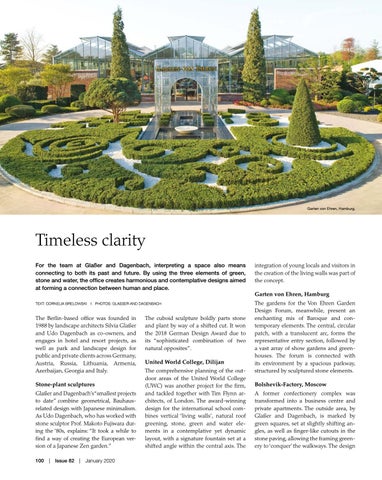Garten von Ehren, Hamburg.
Timeless clarity For the team at Glaßer and Dagenbach, interpreting a space also means connecting to both its past and future. By using the three elements of green, stone and water, the office creates harmonious and contemplative designs aimed at forming a connection between human and place.
integration of young locals and visitors in the creation of the living walls was part of the concept.
TEXT: CORNELIA BRELOWSKI I PHOTOS: GLASSER AND DAGENBACH
The gardens for the Von Ehren Garden Design Forum, meanwhile, present an enchanting mix of Baroque and contemporary elements. The central, circular patch, with a translucent arc, forms the representative entry section, followed by a vast array of show gardens and greenhouses. The forum is connected with its environment by a spacious parkway, structured by sculptured stone elements.
The Berlin-based office was founded in 1988 by landscape architects Silvia Glaßer and Udo Dagenbach as co-owners, and engages in hotel and resort projects, as well as park and landscape design for public and private clients across Germany, Austria, Russia, Lithuania, Armenia, Azerbaijan, Georgia and Italy. Stone-plant sculptures Glaßer and Dagenbach’s“smallest projects to date” combine geometrical, Bauhausrelated design with Japanese minimalism. As Udo Dagenbach, who has worked with stone sculptor Prof. Makoto Fujiwara during the ‘80s, explains: “It took a while to find a way of creating the European version of a Japanese Zen garden.” 100 | Issue 82 | January 2020
The cuboid sculpture boldly parts stone and plant by way of a shifted cut. It won the 2018 German Design Award due to its “sophisticated combination of two natural opposites”. United World College, Dilijan The comprehensive planning of the outdoor areas of the United World College (UWC) was another project for the firm, and tackled together with Tim Flynn architects, of London. The award-winning design for the international school combines vertical ‘living walls’, natural roof greening, stone, green and water elements in a contemplative yet dynamic layout, with a signature fountain set at a shifted angle within the central axis. The
Garten von Ehren, Hamburg
Bolshevik-Factory, Moscow A former confectionery complex was transformed into a business centre and private apartments. The outside area, by Glaßer and Dagenbach, is marked by green squares, set at slightly shifting angles, as well as finger-like cutouts in the stone paving, allowing the framing greenery to ‘conquer’ the walkways. The design
